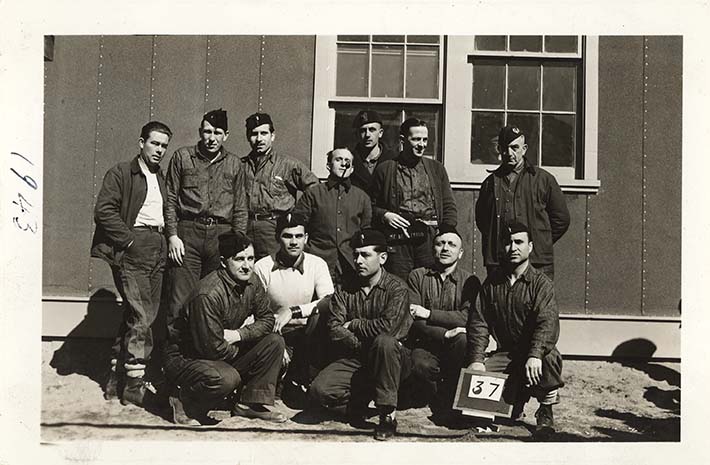Photograph of internees with fascist berets - solo in inglese
Double row of 12 internees; five are crouched in the front. Clothing suggests the picture was taken in spring or in the fall. An identification card reading "37" is positioned on the ground in front of the internee crouched at the far right. The group is positioned in front of a building whose facing seems to be comprised of studded wood planks with two framed windows. First man crouched at the far left is believed to be Antonio Di Pietro; crouched to his left is Osvaldo Giacomelli (in the white sweater). This image is clearly taken at the same time as DICEA2011.0001.0014.
Photograph is dated in black ink to 1943. As a result, this picture would have been taken in Fredericton Internment Camp, where the remaining Italian Canadian internees were transferred in July 1942. The identification card used suggests it was a formal picture taken by a government official.
Most of the men pictured are wearing a beret. The individual standing second from the far right is holding his beret. Visible on the side is the saying "Me ne frego", which translates to "I don't give a damn". The motto is linked to Italian fascism, used by supporters of Mussolini. Earlier articles on the subject used such symbols and other activity to imply fascist support by Italian Canadian internees. A recent review by anthropologist Sam Migliore in Beyond Barbed Wires: Essays on the Internment of Italian Canadians, notes the need to consider multiple-meanings when analyzing symbols. As he notes, "symbols of any kind are human constructions that have no meaning in-and-of themselves". While wearing the berets may in fact suggest facist sympathy and support, it may also reflect group belonging and identity, or resentment for the internment experience. In fact, "Me ne frego" and versions thereof are still used (although considered vulgar phrases). This modern usage is not linked to fascism or implied political affliliations.
This photograph belongs to a collection preserved by Italian Canadian internee Osvaldo Giacomelli. Previous to his death, he had spoken on the record about his internment to journalists and academics. Some suggestion has been made that Giacomelli was a fascist supporter and Mussolini-adherent. He was one of the longest-serving of the Italian Canadian internees, released on May 29, 1945. Giacomelli himself felt that he was wrongfully interned, and sued the Government of Canada in 2005. When Giacomelli died in March of 2006, his case was still unresolved.












